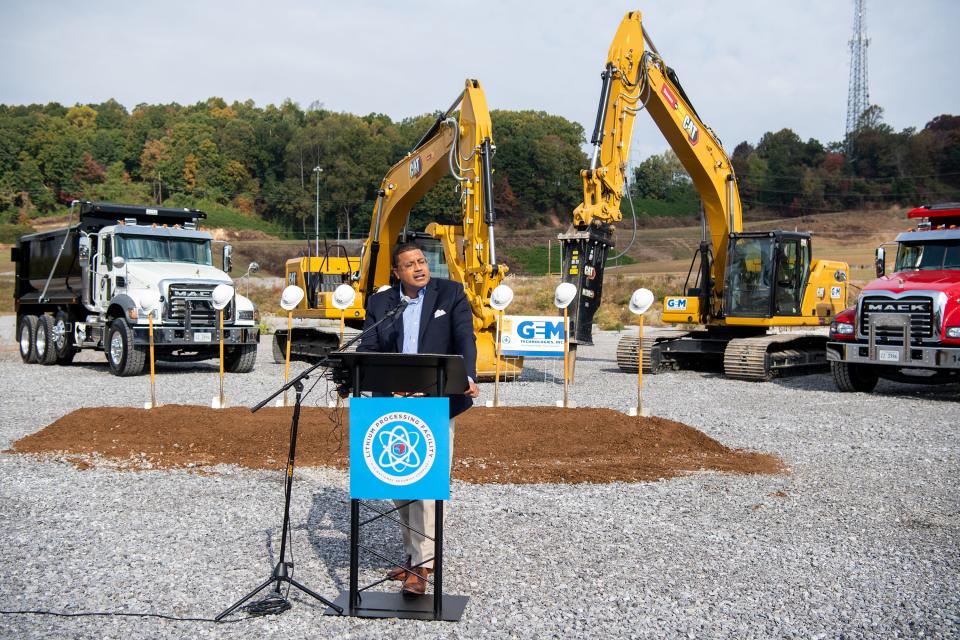ORNL research effort could define future of Navy's nuclear fleet, and some want it to end
- Oops!Something went wrong.Please try again later.
U.S. Rep. Chuck Fleischmann is pushing to defund a nuclear nonproliferation research program that supports work at Oak Ridge National Laboratory in his district.
Since 2016, Congress has given $100 million to three national laboratories to develop a new kind of fuel for the U.S. Navy, which powers all its aircraft carriers and submarines with onboard nuclear reactors.
Fleischmann, chairman of the House subcommittee on energy and water projects, recommended the program to find a low-enriched uranium fuel for the Navy lose its $20 million budget.
Where other Navy vessels use gas and oil as fuel, much like a combustion engine in a car does, aircraft carriers and submarines use uranium from decommissioned nuclear weapons. The so-called "Nuclear Navy" was born in Oak Ridge after World War II, as scientists scrambled to find uses other than weapons for nuclear power.
Outside of a few research reactors transitioning to low-enriched uranium fuel, naval reactors are the only items other than weapons that use bomb-grade uranium in the U.S.
The powerful fuel is an advantage to the Navy since it doesn't require refueling and allows for compact reactor designs, but it concerns advocates of nuclear nonproliferation.
If a nation asserts it will produce bomb-grade uranium for naval reactors, as Iran has done, it can use a loophole in International Atomic Energy Agency guidelines to avoid normal safety inspections for decades, warned scientists and policy experts in a letter to President Biden in 2021.
The Navy's continued use of weapons-grade uranium could encourage other nations to make the dangerous material, experts say, and the U.S. may have to restart production when its supply runs out.
The U.S. has not produced uranium for weapons since 1964 and ended all production of bomb-grade uranium in 1992.
In reports to Congress in 2014 and 2016, the Navy said developing a new fuel would take at least 15 years and nearly $1 billion. It also said the fuels could make naval vessels less effective and more expensive.
The research program's budget, a fraction of a percent of all energy and water spending, was left out of the latest National Defense Authorization Act, which sets funding levels and priorities.
Fleischmann did not offer an explanation for wanting to defund the search for a new naval fuel and his office did not respond to emails and calls requesting comment.
Funding for the program was extended through early 2024 in November, when Congress failed to reach a spending agreement. It is set to expire Jan. 19, the deadline for Congress to pass new spending bills and avoid a potential government shutdown.
House Speaker Mike Johnson, R-La., and Senate Majority Leader Chuck Schumer, D-N.Y., said Jan. 14 they had introduced a stopgap bill that would extend funding, including for energy and water projects, to March 1.
The bill is set for a fight in the House, where a faction of the GOP opposes the measure, pushing for increased border control and less spending overall.
Fleischmann wants to defund research, despite nuclear record
Fleischmann has been a strong proponent of nuclear safety and advanced nuclear reactors such as the small modular reactors under development by the Tennessee Valley Authority in his district.
In a statement accompanying his $58 billion budget proposal for energy and water projects, Fleischmann said national defense and a strong nuclear deterrent against China and Russia are "the highest priority of the federal government."
Only three other navies — those of India, Russia and the United Kingdom — use highly enriched uranium fuel. The French Navy uses low-enriched uranium fuel and experts think the Chinese Navy uses low-enriched uranium fuel.
The uranium used by the U.S. Navy is potent, composed between 93% and 97% of an explosive isotope. It is stored at Y-12 National Security Complex in Oak Ridge and processed into naval reactor fuel by a private company in Erwin, Tennessee, called Nuclear Fuel Services.
Oak Ridge is instrumental not just in storing bomb-grade uranium, but in research that could push the Navy beyond it. In the last few years, samples of low-enriched uranium fuels have been tested for naval use at the High Flux Isotope Reactor at ORNL, according to a National Nuclear Security Administration report to Congress.
Fleischmann has supported a multibillion-dollar effort to spur domestic production of low-enriched uranium for advanced nuclear power reactors, which the U.S. relies on Russia to import.
Yet he recommended defunding the development of the same kind of fuel for the Navy in a separate report, troubling advocates of nonproliferation.
“Members of Congress usually fight in favor of programs in their district. They don’t usually fight to kill programs in their district, so it’s kind of like a man-bites-dog story,” Alan Kuperman, a professor of public affairs at the University of Texas at Austin, told Knox News. “In (Fleischmann's) big bill, this is a rounding error, so this is not about money. This is about principle.”
NNSA and Navy skeptical about new naval fuel
Fleischmann is not the only opponent of the research. The Navy declined to continue the program in 2017, passing it along to the Department of Energy's National Nuclear Security Administration, where it has received a lukewarm response.
In December, the Nuclear Proliferation Prevention Project at UT Austin published a previously private progress report on the research to Congress.
The National Nuclear Security Administration report is the first time the agency has publicly acknowledged the program, said Kuperman, who leads the nonproliferation program.
In the report, Jill Hruby, the top National Nuclear Security Administration official, said she was "pleased with the progress" the agency had made towards developing a new naval fuel. In a sign of the agency's ambivalence, she also referenced Navy reports that suggested low-enriched uranium fuel would harm the effectiveness and cost of its vessels.
Kuperman said he wants hard evidence that the fuels would reduce the power and endurance of aircraft carriers and submarines.
“The premise has always been, we’ll only do this conversion if it doesn’t affect the performance," Kuperman said.
While the National Nuclear Security Administration declined to comment on pending legislation, a spokesperson for the agency said bomb-grade uranium provides the Navy "distinct advantages in naval warfare while upholding the highest nonproliferation standards."

New Navy fuel could achieve nuclear nonproliferation
Nuclear nonproliferation in the U.S. has long centered on transitioning away from bomb-grade uranium in research reactors and discouraging production of bomb-grade uranium.
For decades, advocates for nuclear nonproliferation have pushed the Navy to instead develop a low-enriched fuel, which cannot be easily used in weapons and powers most research reactors.
Calls for a safer naval fuel have intensified since the $245 billion AUKUS security agreement between Australia, the United Kingdom and the the U.S. in 2021. The centerpiece of the deal is the delivery of a nuclear-powered submarine fleet to Australia, scheduled to begin in the 2040s, to combat China's military power in the Indo-Pacific region.
In a letter to President Joe Biden shortly after the deal was reached, several members of the House and Senate urged him to support research into low-enriched uranium fuels for the new submarines. Australia is set to become the first state without nuclear weapons to maintain a stockpile of bomb-grade uranium.

"We are concerned that other nations with weaker nonproliferation records may point to the Australian precedent to develop nuclear weapons under the cover of a naval reactor program," the letter to the president said.
Sen. Ed Markey, D-Mass., signed the letter to Biden. In a statement to Knox News, he said Congress needs to fund the research to prevent bomb-grade uranium from being the Navy's only fuel option.
“High-enriched uranium means a higher risk of nuclear proliferation, and our country has a responsibility and a commitment to maintain to lead on nonproliferation - not lose interest in it," Markey said. "We need to keep funding this advanced (low-enriched uranium) fuel research so that high-enriched uranium doesn’t fall into the wrong hands.”
Another concern is the U.S.'s limited store of bomb-grade uranium for naval reactors. Set to run dry in the 2050s, the finite stockpile raises the specter that the U.S. would revive production of bomb-grade uranium.
In a 2020 report from the Government Accountability Office, National Nuclear Security Administration officials said the U.S. would need to restart production of highly enriched uranium or else run out of fuel for the Navy in the 2050s.
Time is running out for Navy to switch fuels
A report from the Navy in 2016 said it could take 15 years to develop a low-enriched uranium fuel for aircraft carriers and submarines.
That timeline will run up against the Navy's decision on how to fuel its next class of attack submarines, a decision which could be made by 2030, according to a declassified report from JASON, a group of scientists who advise the U.S. government on sensitive science and technology issues.
Dedicated to reactors that span the lifetime of a submarine, the Navy has been hesitant to develop fuels that would require refueling.
“Essentially, the Navy is giving zero priority to nonproliferation. They consider that’s not their department," Frank von Hippel, senior research physicist and professor emeritus at Princeton and a global leading expert on nuclear security, told Knox News.
Because its support has come from a handful of leaders in Congress, the research program could disappear if it’s defunded in the next energy and water appropriations bill, von Hippel said. That most of its supporters are Democrats and its detractors Republican may invoke a broader divergence in the two parties.
“I think there's a difference in view on the power of the U.S. example,” von Hippel said. “Democrats tend to believe that if we want other countries not to use (highly enriched uranium), in this case for naval reactors, then our example is important. I think the Republicans are skeptical of that kind of idealistic argument.”
Last March, three other House members wrote Fleischmann a letter asking that he consider supporting the research.
Reps. Bill Foster of Illinois, John Garamendi of California, and Rick Larsen of Washington, all Democrats, argued that research on low-enriched uranium fuel was an opportunity to advance aging technology and it needed to be done before the Navy designs new submarines.
"These design phases occur only every few decades, given the many years required to build a submarine and their decades of service-life," the letter said. "The design phase for the successor to the Virginia-class submarines will begin soon. The window for incorporating safer fuel will close shortly thereafter and will not reopen until the late 21st Century."
Daniel Dassow is a growth and development reporter focused on technology and energy. Phone 423-637-0878. Email daniel.dassow@knoxnews.com.
Support strong local journalism by subscribing at knoxnews.com/subscribe.
This article originally appeared on Knoxville News Sentinel: Fleischmann poised to pull plug on ORNL nonproliferation research

